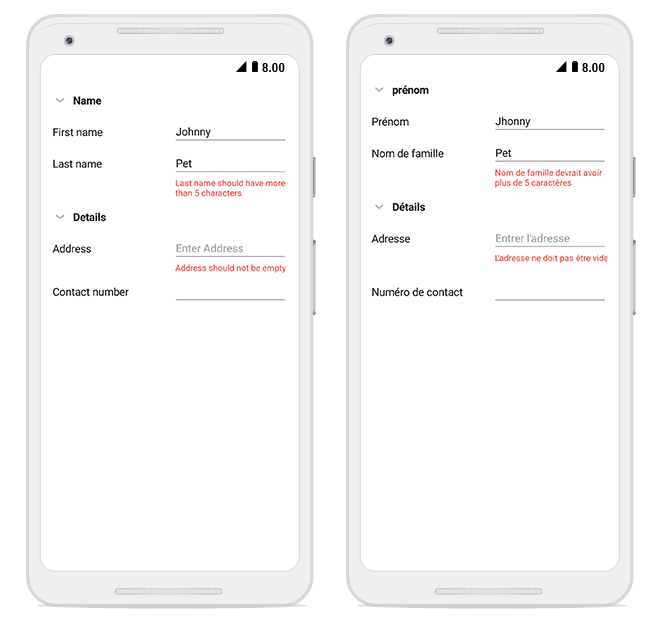Localization in Xamarin DataForm (SfDataForm)
8 Jan 20254 minutes to read
You can localize the DataFormItem Display attribute values and validation (Required ,StringLength ) attributes values by using ResourceType display attribute or using the AutoGeneratingDataFormItem event.
Please refer the Localization document to localize the application.
Based on the culture specifies the corresponding culture string value of display attribute in Resource (.Resx) file as mentioned in document.
Localizing data form item display values
Here, the display attributes or data form item display values get localized based on culture from Localization Resource File (.Resx).
Using attribute
ResourceType Display attribute specifies the Resources File (.Resx) which is used to localize the Display attribute of Name, ShortName, GroupName and Prompt values.
[Display(Name ="FirstName", Prompt = "EnterFirstName", GroupName ="Name", ResourceType = typeof(Localization))]
public String FirstName { get; set; }Using event
You can also localize the DataFormItem LabelText, PlaceHolderText, GroupName in the AutoGeneratingDataFormItem event of SfDataForm by using the Resources (.Resx) file.
Here, string member of .resx file will be accessed through the class (in resxFilename.Designer.cs) which was auto-generated when .resx file created and static string members get localized using ResourceManager based on culture.
[Display(GroupName ="Name")]
public String FirstName { get; set; }
dataForm.AutoGeneratingDataFormItem += DataForm_AutoGeneratingDataFormItem;
private void DataForm_AutoGeneratingDataFormItem(object sender, AutoGeneratingDataFormItemEventArgs e)
{
if (e.DataFormItem != null)
{
if (e.DataFormItem.LabelText == "FirstName")
{
e.DataFormItem.LabelText = Localization.FirstName;
e.DataFormItem.PlaceHolderText = Localization.EnterFirstName;
}
if (e.DataFormItem.GroupName == "Name")
{
e.DataFormItem.GroupName = Localization.Name;
}
}
}Localizing validation error messages
Here, the validation (Required,StringLength) attributes or data form error messages get localized based on culture from Localization Resource File (.Resx).
Using attribute
The Required and StringLength attributes error message can be localized using ErrorMessageResourceType and ErrorMessageResourceName properties which are used to get a localized error messages from Localization Resource File (.Resx) based on culture.
[Required(AllowEmptyStrings =false,ErrorMessageResourceType = typeof(Localization), ErrorMessageResourceName = "FirstNameEmpty")]
[StringLength(25,MinimumLength =5,ErrorMessageResourceType = typeof(Localization), ErrorMessageResourceName = "FirstNameLength")]
public String FirstName { get; set; }Using event
You can also localize the data form error message in the ` Validating` event of SfDataForm by using the Resources (.Resx) file.
Here, string member of .resx file will be accessed through the class (in resxFilename.Designer.cs) which was auto-generated when .resx file created and static string members get localized using ResourceManager based on culture.
dataForm.Validating += DataForm_Validating;
private void DataForm_Validating(object sender, ValidatingEventArgs e)
{
if (e.PropertyName == "FirstName")
{
if (e.Value.ToString().Length == 0)
{
e.IsValid = false;
e.ErrorMessage = Localization.FirstNameEmpty;
}
else if (e.Value != null && e.Value.ToString().Length > 0 && !(e.Value.ToString().Length >= 5))
{
e.IsValid = false;
e.ErrorMessage = Localization.FirstNameLength;
}
}
}
You can download the entire source code of this demo for Xamarin.Forms using attributes from here LocalizationThroughAttribute and using event from here LocalizationThroughEvent.